Alfred Silvester – the Fakir of Oolu and his Family of Magic
Chapter Nine – Alfred Silvester Silvester [continued]Misfortune appears to stick to some men with the greatest pertinacity. And Mr. Alfred Silvester seems to be one of these unfortunate individuals.
– Daily News, Perth February 28, 1888
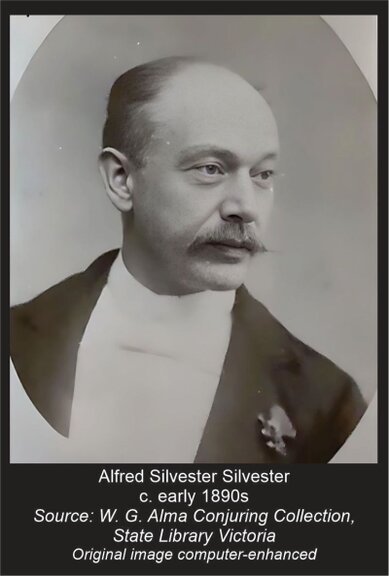
In Chapter Seven, we left Alfred Silvester Silvester lately bankrupted and making only occasional forays into theatre during 1882, with the management of “Popular Concerts”. In June of that year, prior to the departure of his father from Western Australia, the whole Silvester family had joined for two nights only, presenting a show at St. George’s Hall Perth.
It is no slight to Western Australia to note that in the 1880s, what was still a Colony had some way to go towards becoming a mature and prosperous State. Self-government was not granted until 1890, and it was only the mid-1890s, with the discovery of gold at Kalgoorlie and Coolgardie, that the population grew to a level capable of sustaining a viable theatrical community. Alfred, whatever his reasons for living there, was not in an ideal place to make a living from magic.
Alfred had made some connections with the Herald newspaper, and was engaged with them in the capacity of reporter, as well as being a ‘canvassing agent’ selling shares for the start-up Loan and Discount company. Even this employment went astray for Silvester. When the company’s bank stopped payment, Silvester was deprived of some of his commission earnings, and he was then dragged into court as a witness in a libel suit between the ‘Herald’ and the Discount company.
In January 1883, however, a new variety company arrived at Fremantle from overseas. They were “Archer’s Surprise Party”, and there were two principals: Mr. Archer, a ‘Dutch and Irish’ comedian, and Miss Lilly/Lillie De Vere (Mrs. Archer), a petite danseuse and singer with a serio-comic style. She would go on to be a fixture in Australian and international musical theatre until the early 1900s. The troupe engaged both Silvester and Hector Lacie the ventriloquist, and they opened on January 3 to favourable commentary but small audiences, moving through York, Northam and Newcastle (now named Toodyay). Alfred indulged the Silvesters’ love of convoluted titles, performing “Ambidextriprestigigation”.
For some unknown reason, the people of York were unsatisfied with the performance, and on the second night the Surprise Party did not exhibit. They fared little better in Newcastle, where it was reported that “they had very poor houses on the two nights of their performance, and what was taken could not have done more than pay expenses. And yet, on the whole, the entertainment was fairly creditable.” Busselton reported ‘very indifferent patronage’. A southern tour taking in the Murray and Pinjarrah districts was slightly more successful.
The company decided on a radical change to their performances, to present Tom Taylor’s sensational 1863 drama “The Ticket-of-Leave Man” (1) at St. George’s Hall, Perth. The roles were taken by each of the existing players plus two amateurs, with Silvester in the part of Jem Dalton. Initially there was resistance to the production’s title and theme from a sensitive portion of the community. A local paper refused to accept advertising, posters were not permitted to be pasted up unless the words “Ticket of Leave Man” were omitted, and one citizen openly announced his readiness to spend up to £50 to procure “the admission of a body of roughs, who will be engaged to rush the stage as soon as the curtain is raised.” (2)
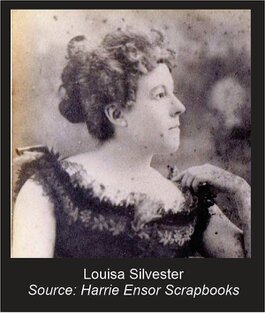
Other papers ridiculed the objectors:
“We’ve seen it played, and draw hot tears;
We’ve seen it conjure up bright mirth;
Its purity’s been known for years;
Yet ‘tis not good enough for Perth!
…
What fools these poor dull people are!
For grin at them the world now will;
They’ve shown us that they feel the scar,
And hear the clank of leg-irons still.”
In the event, the house was full on opening night, February 19, and Mr. Silvester was noted as evoking “great applause” while Hector Lacie “excited the interest of the audience, and held them in rapt attention by his powerful acting.” (3). The immediate success of the play might have turned around the fortunes of the company, which now re-titled itself “Archer’s Dramatic Company” and continued to tour until March. However Mr. Archer was unhappy with the treatment he had received in Australia, and far from producing his next proposed play, “Ten Nights in a Barroom”, he departed in April with his wife and Mr. Lacie, for Hong Kong. By October of that year the Archer party was reported to be in Singapore and playing to good houses. Hector Lacie, in the absence of a magical offsider, took on the role himself and performed the Vanishing Bird Cage, and Fish [production] tricks.
Louisa Silvester gave birth on February 20 1883 to her second child, a daughter, who was named Violet Isabel Silvester. (17)
Alfred continued to be out of public view for some time, though he formed a company with the intention of holding balls, concerts and variety entertainments on occasion. In October 1884 he created a “Bower Arcadia” or “North Pole Frigid American Marble Fountain” in Hay Street, serving iced non-alcoholic drinks, and ice creams.
1885 saw a partial revival of Alfred’s performing as a magician, though it was clear that Perth could not offer any hope of rewarding a regular entertainment; his show was mentioned as “one of the rare opportunities for an evening’s recreation in Perth.” Supported by a troupe of amateur helpers, Mr. and Mrs. Silvester’s grand Drawing Room Entertainment opened on April 30. On the first evening, Silvester drew enthusiastic plaudits from a delighted audience for an old favourite performer.
The following evening, however, and in the presence of His Excellency the Administrator, the gallery and back seats were packed with a crowd of “larrikins” both young and old, who disrupted the show from start to finish with a chorus of insulting comments and interjections. Amongst the other musical and comic performances, Mr. Silvester “maintained his reputation as an illusionist, and shewed that want of practice had not in any way lessened the dexterity which enables him to defy the scrutinising eyes of those who are eagerly watching to detect the way in which it is done.”
The behaviour of the ‘cads and blackguards’ caused a fortnight of navel-gazing in the press about the appalling lack of decorum in Perth, and the West Australian came close to publishing a list of names of those involved. A Perth so-called “gentleman”, according to one correspondent, would never pass muster under that title in any other place. Alfred wrote a letter of regret to His Excellency, who responded sympathetically that he was glad to hear there was a chance of bringing some of the ringleaders to account for their behaviour. A follow-up performance at the Fremantle Oddfellows’ Hall on May 13 was successful, and the Inquirer remarked that “the ‘Gods’ behaved in an exemplary manner, and their example is worthy the emulation of the young and old larrikins whose disreputable conduct at the late entertainment in Perth has been so righteously condemned.”
Happy to keep their hands in whenever opportunities arose, the Silvesters took roles in Tom Robertson’s comedy, “Caste” in September, and the West Australian remarked (September 23), “Were the people of Perth insured a succession of enjoyments such as this, the city would soon come to be held a much more desirable place of residence than at present.” The role of Old Eccles, played by Mr. Silvester was “a performance of great humour, and his fun, though bordering a little on the farcical, seemed to be considered by many of the audience the happiest feature of the entertainment.” Mrs. Silvester, as Polly, played with “utmost sprightliness and vivacity in a particularly smooth and off-hand manner, but with occasionally a little too much tendency to introduce ‘gag.’ “ It would be Mrs. Silvester, however, who made a name for herself as an actress in Perth plays during the next several years.
Thauma – the Disembodied Woman
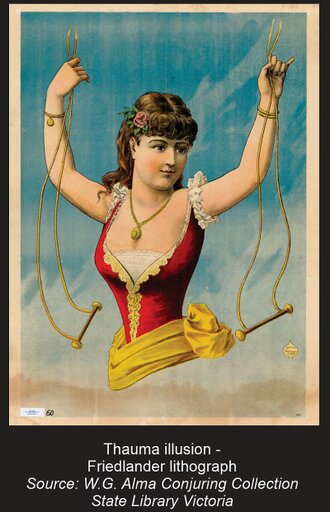
Alfred Silvester had a flirtation, in December 1885, with a stage illusion titled “Thauma”; and although it was a brief encounter, he would later return to the same illusion. It seems that this was the start of his involvement in what might be termed “Amusement Museum” effects – static illusions and optical effects which could be displayed as an exhibition rather than a performance, in the style of Barnum and Bailey’s tent exhibitions.
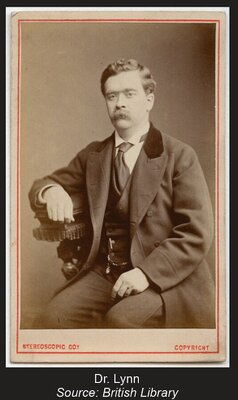
The Greek word “Thauma”, meaning ‘wonder’ or ‘miracle’, already had its place in the world of magic, as performers were known as “thaumaturgists”. The new illusion, exhibited with huge success in Europe around 1884 or a little earlier, was the creation of Dr. Lynn (Hugh Simmons Lynn) (4) who came to Australia in 1863 as ‘Washington Simmons’ and again in late 1886. Lynn invented a number of dramatic stage illusions including a Vivisection feat advertised as “Another man cut up tonight.”
The Thauma illusion, capable of being toured and exhibited by a non-magician, involved what seemed to be the upper half of a young lady, with no lower torso, sitting on a swing inside a curtained enclosure. Viewers could shake hands with the lady, or pass a sword beneath her body to show that nothing was hidden below. Unlike so many of the illusions of this era, no mirrors were involved, the illusion being created by a combination of the lady’s position, a drapery in black, and a false bodice. Thauma was doing great business in the Eastern States of Australia early in 1885, and she arrived on the West coast in December. At Christmas time, Alfred enhanced the production by adding his magic to a show at the Oddfellow’s Hall, along with Mrs. Silvester performing the classic “Masks and Faces” routine.
Silvester performed intermittently, and 1886 saw him at Victoria Plains with a well-patronised magical entertainment. He also became involved, in some fashion (he is not listed as an actor), with the ‘Royal Dramatic Company’ a well organised troupe of artistes led by Duncan Macallum with Miss Marian Willis and Mr. J.B. Steele heading up an extensive repertoire which included The Shaughraun, Hamlet, Pygmalion and Galatea, She Stoops to Conquer, and many more. The company arrived in Western Australia in February and for a time it seemed they would prosper, with a highly professional approach and regular change of performance. Whether by lack of support or simply a population size which could not sustain them, by June the Royal Dramatic Company dissolved, their loss lamented by the press.
A few of the leads remained at Perth, and in August Alfred joined them at the Town Hall for a well-attended evening in which he performed magic, and Miss Willis and Mr Steele performed a selection from ‘Pygmalion’, with a farce to conclude. The other performer, William Karl the gymnast, met with trouble when he slipped during a trapeze feat (possibly his famed double somersault) and temporarily knocked himself unconscious. The programme was repeated on August 7, with Tom Taylor’s comedy “Nine Points of the Law” as the feature, and Silvester’s Vanishing Bird Cage drawing acclaim.
A few of the leads remained at Perth, and in August Alfred joined them at the Town Hall for a well-attended evening in which he performed magic, and Miss Willis and Mr Steele performed a selection from ‘Pygmalion’, with a farce to conclude. The other performer, William Karl the gymnast, met with trouble when he slipped during a trapeze feat (possibly his famed double somersault) and temporarily knocked himself unconscious. The programme was repeated on August 7, with Tom Taylor’s comedy “Nine Points of the Law” as the feature, and Silvester’s Vanishing Bird Cage drawing acclaim.
Mrs. Silvester was also active on the stage, though with another touring company, the Jackson and O’Neil Dramatic Company, playing Mrs. Shelby in “Octoroon.”
Mr. Silvester and the “Marian Willis Company” were still at Perth in mid-August, and once again a concert was presented with Silvester’s legerdemain, and scenes from “Oliver Twist.” Alfred was finally noted amongst the actors on August 18, in the role of ‘Cunninghame’ in the comedy-drama “The Widow Hunt.” These sort of variety nights fitted neatly with Silvester’s existing line of managing ‘popular concerts’, and they were successful in drawing the audiences in large numbers. Alfred finished out the year with a few more concert nights on behalf of the new ‘Working Men’s Club’.
Mr. Silvester and the “Marian Willis Company” were still at Perth in mid-August, and once again a concert was presented with Silvester’s legerdemain, and scenes from “Oliver Twist.” Alfred was finally noted amongst the actors on August 18, in the role of ‘Cunninghame’ in the comedy-drama “The Widow Hunt.” These sort of variety nights fitted neatly with Silvester’s existing line of managing ‘popular concerts’, and they were successful in drawing the audiences in large numbers. Alfred finished out the year with a few more concert nights on behalf of the new ‘Working Men’s Club’.
The year 1887 saw something of an increase in performing by Mr. and Mrs. Silvester, and on May 20 they welcomed their third and last child, a daughter, Daisy Emma Louisa Silvester. Despite this, there was trouble brewing in the family, which would come to a head in the following year.
Alfred was seen at a large fund-raiser for the local orphanages in mid-June. In September, Louisa Silvester played as ‘Caroline Effingham’ in “Tom Cobb” by the Perth Amateur Comedy Society, and she was the recipient of a benefit evening. The pair were working together on October 10 and 11 with their drawing room entertainment, “Mysteria” at St. George’s Hall, perfoming all their best-known feats including the ‘Sleeping Beauty’ in conjunction with an exhibition of the Thauma illusion; although it seems that the Silvesters were the operators of Thauma, it was not specifically mentioned. A notable inclusion in this show were the duets by “Mrs. and Master Silvester” – a very early appearance by Alfred3 [Alfred William Silvester] who was just twelve at the time.
“Mysteria” played again at the Geraldton Masonic Hall on November 5, again with Thauma on the bill; and the Victorian Express made mention that “…. The son of the late Fakir of Oolu occupies a very prominent position amongst modern illusionists, and we regret for his sake that he is not in a larger community, where his merits would be better appreciated.” At the same hall, husband and wife appeared in a concert with magic and music on November 28, and took roles in the “screaming farce, The Dumb Belle” – Mrs. Silvester was again the recipient of a benefit night.
1888 – Separation, Divorce, Adversity and Continuity
Though publicly we can only see the theatrical face of Alfred and Louisa Silvester, 1888 was a catastrophic year for both, and with hindsight we find extra clues about Alfred’s rather unproductive years in Western Australia.
January 1888 began with a commentary from the Victorian Express (5), “… benefit to Mr. Alfred Silvester on Thursday evening next. Mr. Silvester is one of the most accomplished entertainers in his own particular line, who have ever visited Australia, but this colony is not an Eldorado for the travelling performer, and Mr. Silvester has not met with the success he deserves.”
Just a month later: “Misfortune appears to stick to some men with the greatest pertinacity. And Mr. Alfred Silvester seems to be one of these unfortunate individuals. A few weeks ago he left Perth for Geraldton, in order to hold a short season of variety entertainments at that town and in the neighbouring district. The season, however, proved the reverse of successful; and now Mr. Silvester has received the crowning strike of ill luck. He had intended to give an entertainment at Greenough, in the faint hope of recovering at least a portion of the losses he had suffered. With this view he had just forwarded all his apparatus and family luggage to Greenough when the flood occurred, by which the whole of his property was either carried bodily away or utterly spoiled. In a letter to one of his Fremantle friends, Mr. Silvester declares that he is now utterly ruined.”
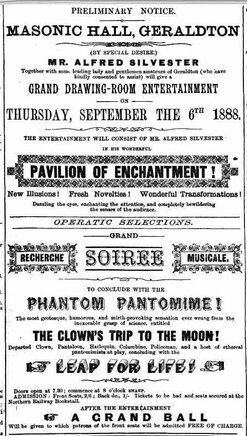
On the face of things, it seems that Alfred was not completely down and out; from August 25 he began to advertise a return to the stage at Geraldton Masonic Hall on September 6, with new illusions and fresh novelties, assisted by some “leading lady and gentlemen amateurs of Geraldton who have kindly consented to assist”. Mrs. Silvester was not mentioned, and there is some question as to whether this performance ever took place, as the Victorian Express of October 6 made reference to a ‘repeated postponement of this performance’.

What did eventuate, however, was a revival of the Pepper’s Ghost Illusion, accompanying two dramatic playlets – “Christmas Bells”, an adaptation by Garnet Walsh of Charles Dickens’ “A Christmas Carol”, and a tragedy, “The Burgomaster’s Dream.” The cast included both Alfred and “Master [Alfred3] Silvester” and a reference was made to a closing farce, the “Ghosts of the Blue Room”, which begs the question whether Alfred might have been experimenting with a new evolution in the Pepper’s Ghost illusion. Via the use of a partially silvered glass, it was now possible for a person to gradually and visibly change into a ghost, or a skeleton, or some monstrous figure.
Sadly, it seems that technical difficulties would haunt this production. The Victorian Express (7) regretfully reported:-
“The much advertised and long expected Ghost illusion boomed forth on Thursday evening last [October 18]. The bills have been asking persistently, “Have you seen the Ghost?” to which I now reply sadly, “I have.” I went and witnessed the awful solemness, and ever since have had a pain in my mind …. Mr. Silvester’s acting as Silas Hardman was very good, and his make-up faultless, but he evidently forgot the greater portion of his text, which considerably marred the performance … the apparitions … merely appeared, did their business, and like well-behaved ghosts vanished. During this pieces the curtain was lowered rather unceremoniously but after a few minutes delay it was again raised, and Xmas Bells went on merrily. After a weary delay of fifteen minutes Mr. Silvester read the introductory lecture to the Burgomaster’s Dream … another weary interval and the curtain rose, but as soon as the lady commenced the curtain fell with a crash … another short interval and the comedy of the Haunted House was proceeded with … the prompter’s voice was much too audible to be pleasant … the canvas and paint, the properties and mechanism, even the green curtain seemed to have entered into an unholy conspiracy with the ghosts, and refused to do what was right and proper … Mr. Silvester has … an unhappy faculty for “long waits” which almost invariably militate against his success. This weakness has been candidly and kindly pointed out to him in Geraldton more than once but so far to very little purpose. Geraldton audiences cannot be described as unappreciative … but for the shortcoming in matters of stage management to which I have referred.”
Louisa Silvester departs Western Australia
The events which took place between 1888 and 1893 cannot reflect well on Alfred’s character. Despite the many setbacks he had experienced over the last decade, his apparent abandonment of his wife and two youngest children seems to have no redeeming features. Most of the detail about the separation and divorce of Louisa and Alfred comes from several years after 1888, when Louisa filed for divorce in an uncontested suit. (8)Louisa had been given a benefit night at Fremantle on October 5, in which she participated in the role of “Aunt Hettie” in “The Open Gate”. The press discreetly referred to “a lady who has been connected with the dramatic profession in the colony for some time, but who has met with adverse circumstances”, and “…she has ever been ready to give her valuable professional assistance gratuitously towards raising funds for many a charitable purpose. Unhappily, however, her lot in Western Australia has not been so pleasant or successful as she deserves; and now the only prospect she sees of improving her position and providing for her young family is to proceed to Melbourne, where she has every reason to believe she will do well both for herself and those dependent upon her.”
It seems that Louisa had effectively been abandoned by Alfred since August, without support. On October 15 she departed for Melbourne aboard the s.s. Victorian, taking her girls but leaving behind young Alfred William Silvester, who remained, at least for now, with his father.
Louisa, in 1888, had neither resources nor the motivation to sue for divorce. It was not until January 1891 that she did so, and then her additional reason was Alfred’s stated adultery with a Miss Annie (‘Queenie’) Sefton, of whom we will learn more in the next chapter. Alfred did not contest the divorce, or even appear in court, but Louisa’s divorce filings provide the story of what had taken place:
“While in Geraldton the respondent constructed or disclosed habits of intoxication which unfitted him for his business. He failed to provide the necessities of life for me and my children and I was compelled to seek for a subsistence for my children and self to avoid starvation... that I left Geraldton in the month of August [1888] for Melbourne [see note 9] and arrived in Victoria in the month of October [1888] where I have resided ever since separate and apart from my husband and without receiving anything for my or my children’s support saving about thirty five pounds paid to me at intervals during the year [1890]”
“…that the said Alfred Silvester Silvester left your petitioner at Geraldton in the Colony of Western Australia in the month of August [1888] without any means of subsistence and your petitioner was compelled to seek her own livelihood by teaching music and other subjects and has, since the said date, supported herself and her children ….”
“… up to the time of my leaving my husband I had no complaint to make on the ground of adultery. After leaving my husband I went to live in Fremantle and remained there some seven weeks & then proceeded to Melbourne … In January 1889 I settled down at Dromana as a teacher of music and during this time … I have been supporting myself and three children out of my earnings as a teacher of music.”
“I am not worth Twenty Five Pounds save and except my wearing apparel.”
A decree nisi was issued in June 1891. Notably, Louisa mentioned three children being supported, which must imply that Alfred3 had since joined his mother and sisters. As late as April 1893 (10) Louisa was forced to proceed against Alfred, alleging that he had left her “and the three children” without proper means of support. Alfred on that occasion had to provide a bail of £10; the outcome is not recorded, but Louisa was still struggling as late as October 1894, when a special benefit night was held in an attempt to aid her financially.
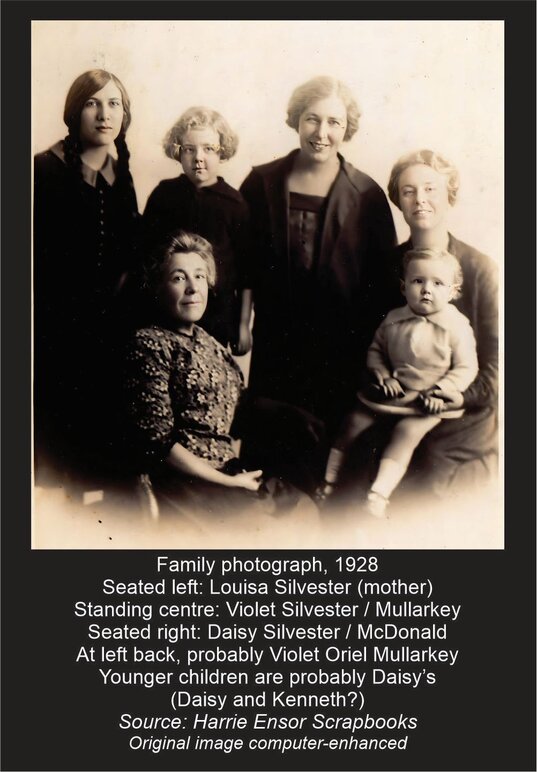
Louisa Sarah Ann Silvester (nee Hutchins) was not a genteel subordinate wife of the 1800s. She was one amongst many of the Silvester women who had talents of her own, and the determination to make use of them. Baptised at Spitalfields on August 18, 1850, the daughter of Henry Hutchins (a tailor) and Louisa Hutchins, she had married Alfred Silvester Silvester at St. James’ Piccadilly on August 30, 1874 just months before the performing family departed for Australia. Louisa had travelled with the troupe, and with Alfred in New Zealand, as an assistant, singer, pianist and performer of such routines as the Entranced Lady (Sleeping Beauty) and Masks and Faces. As an actress in Perth’s local theatrical ventures she was well respected.
She must have struggled in the years preceding her divorce, while living in the Melbourne suburb of Dromana, in 1888 with a daughter just over a year old, another just five, and a young son in his teens. In 1892, however, she re-invented herself. She became Miss Louie Byron and opened at the Gaiety Theatre, Melbourne on November 5; perhaps she could be excused for billing her act as coming from London “after 27 weeks’ run at the Polytechnic."
Her routine came directly from the Silvester playbook – it was the “Masks and Faces” act, billed as a “witty, sparking, satirical, quizzical and comical entertainment, FACIAL CHANGES – lights and shadows of character in the Human Face.” Between 1892 and 1899, she was a constant feature on many bills in all the Eastern States and South Australia including the Sydney Tivoli (September 1893), and the Bijou Theatre Launceston (’the great American Facial Entertainer’), her act reviewed as “a grand feature of a grand entertainment” …. “a novel and interesting performance well worth seeing” … “exceedingly clever”. A costume changing routine, “Ancient and Modern Fashions” was also part of Louie’s act. She toured in New Zealand in 1893 and again years later in 1904 and 1905 (with daughter Daisy Silvester).
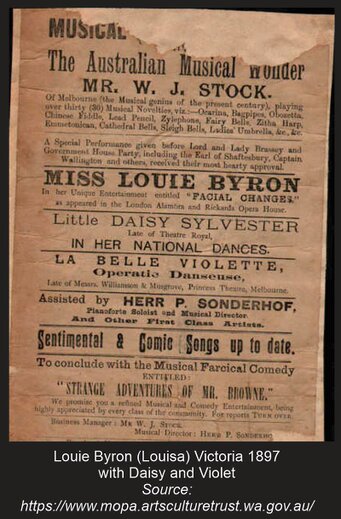
While in New Zealand, the historian Robert Kudarz (Tom Driver) made the unfortunate error of claiming that he recognised Miss Byron. (13) She was, he said, the same famous Daisy Silvester who had been the “Entranced Lady” with the original Fakir of Oolu. Never mind that she was far too young to have been working in the 1870s; Kudarz had simply mixed up his Silvesters - the first “Daisy” had retired from the stage years before.
For all this, it seems that life was still a battle. In October 1894 a special benefit was reported at the Hibernian Hall in Melbourne (11) “…the benefit to the Fakir of Oolu’s grandchildren … Miss Louie Byron (Mrs. Alfred Silvester), the children’s mother is to reappear in her facial changes, and there is a long array of talent besides … the little ones are badly in want and we sincerely hope and trust that there will be a large attendance of the public.” Violet and Daisy also appeared on the benefit but, “unfortunately the public attendance was so small that if the promoters escaped a loss on the affair it would be all they could hope to achieve, and the family it was desired to benefit, although in urgent need, will not be helped in the slightest degree.” (12)
Louisa Silvester and her daughters survived the bad years. Louisa lived until the age of 79, at 159 Bourke Street Sydney, and passed away at her daughter Violet’s residence at 228 Dowling Street, on August 4, 1932.
ALFRED WILLIAM SILVESTER
Alfred William (July 3, 1875 – February 13, 1956) would become the third “Alfred” of the Silvester family, and the fourth male descendant to make his living as a magician; his extensive story will be detailed in a later chapter.
At the time of his mother’s departure from Western Australia, Alfred was still with his father. They both sailed for Albany on February 13, 1889 where shows were given at the Town Hall on February 21 and 25. Afterwards, it seems that Alfred3 moved to Melbourne and joined his mother and sisters, while Alfred2 gave his first Melbourne performance in July.
From about 1897, two young ladies made an appearance on the bills with Louie Byron. They were advertised as “Little Daisy Sylvester” and “La Belle Violette”. Although their careers diverge from our focus on magicians, they became theatrical performers of no small stature.
VIOLET ISABEL SILVESTER / MULLARKEY / BLOOR
Violet, the middle child, was born in 1883. She was to become nothing less than a star of Australian musical theatre, deserving of a more thorough biography than will be given here.
In December 1895, aged just twelve, she was reported in the Fitzroy City Press as having given “a gavotte … had to respond to an encore …” at a school concert.
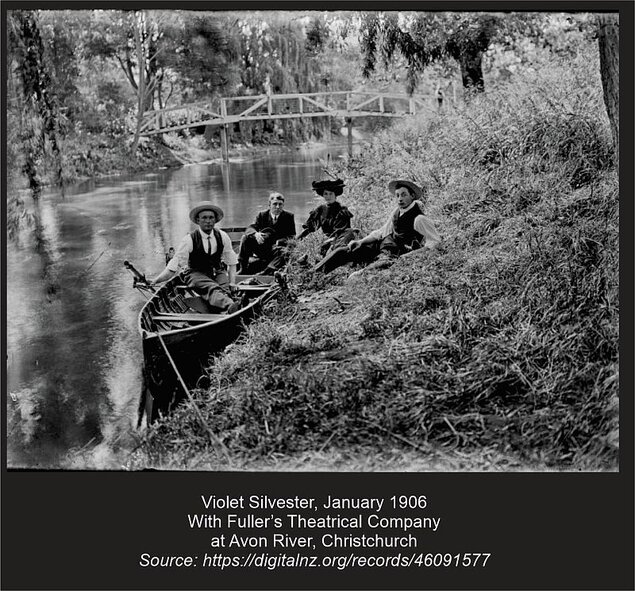
In October 1897, Violet was working with her mother in The Bijou Company at Traralgon; “A young lady called La Belle Violette gave a song and dance, ‘The Spirit of the Lake’ which was deservedly encored, and later on gave a tambourine dance, both numbers being excellent.” (Little Daisy Silvester also “danced an Irish Jig in such a spirited manner as to elicit an encore.”)
Her dancing and acting rapidly took Violet to the best companies in Australia. In April 1901 she was working at Adelaide’s Theatre Royal with the J.C. Williamson dramatic company, one of many roles with JCW up until 1909. Now frequently billed under the spelling “Sylvester”, she would appear in “The Cingalee”, dancing the Devil Dance with Fred Leslie, then in ‘Floradora” as Violante. Violet also worked for the Fuller’s theatrical circuit with which she travelled to New Zealand, and the Robert Brough company (1925 in “Trelawny of the Wells” as Mrs. Telfer, alongside such star artists as Dion Boucicault and Maggie Moore). With other troupes, the Courtiers and the Jesters, she was seen frequently, and highly praised, in the eastern states.
Violet married Richard Lesleigh Mullarkey on September 26, 1907. Mullarkey was a theatrical agent and, at the time, private secretary to J.C. Williamson. Their daughter, Violet Oriel Mullarkey was born in 1911. Without delving too deeply into personal matters, the marriage eventually became almost impossible to sustain, as each tried to balance the demands of theatrical commitments across the country.
By 1916, Richard Mullarkey filed for divorce, on the stated grounds of ‘desertion’. (14) In the documents, he lists no less than twelve separate places of residence up until 1911. Both had been employed on separate engagements travelling around the states, and in 1912 Richard wrote a play for Mr. William Anderson which failed. He suffered a nervous collapse and was unable to find employment, eventually finding a position with Stott’s Business College in Melbourne.
By 1916, Richard Mullarkey filed for divorce, on the stated grounds of ‘desertion’. (14) In the documents, he lists no less than twelve separate places of residence up until 1911. Both had been employed on separate engagements travelling around the states, and in 1912 Richard wrote a play for Mr. William Anderson which failed. He suffered a nervous collapse and was unable to find employment, eventually finding a position with Stott’s Business College in Melbourne.
Relative to Violet and her family, Mullarkey would note “[in 1909] as the respondent was in a good engagement I consented to her continuing in the theatrical profession as she was desirous of helping her mother and sister with her own money and mine.” After the birth of their daughter, “respondent wanted to return to the stage but I refused to allow her to do so.”
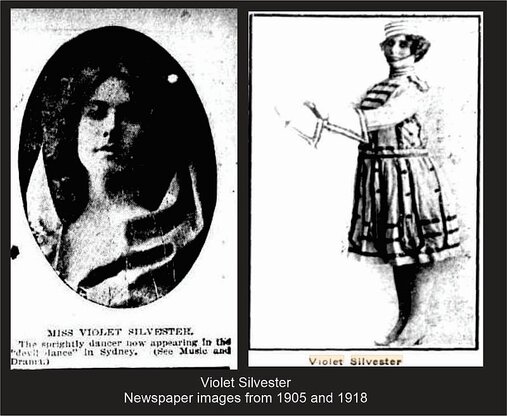
In her response, Violet would state, though her claim was contested, that Richard had been a drinker and that “for the last 4 years I have been forced to take a position on the stage in order to earn sufficient money to keep myself and my child” … “the petitioner has sent me no money [during the last year] and in consequence of my ill health and inability to obtain remunerative employment and my average weekly earning not amount to more than 15/- I am now absolutely without means and I have no separate estate whatever.”
Ultimately, the petition was withdrawn when Mr. Justice Hood decided that the application was premature. However, in 1919 the case was again submitted, after Violet refused to return to live with Richard unless he could provide her with a home instead of ‘lodgings.’ The court granted a decree nisi, and Violet took custody of her daughter.
All the Silvester women lived close to each other in Sydney, in the Paddington / Woolloomooloo area which, though it is now a leafy and upmarket suburb, was decidedly a working-class area in the early 1900s. Violet, though sometimes located in Melbourne, can be sighted living at 228 Dowling Street Sydney as late as 1948; her performing credits extend to 1925, though less frequently after the divorce. A newspaper article of 1947 (15) said “former dancer Violet Sylvester is one of the few who, since leaving the stage, have had many different jobs. They vary from cashier, post mistress at Lake Tyre (Gippsland Victoria) to receptionist at a Blue Mountains holiday resort.”
Richard Mullarkey died in 1945. In 1958 Violet re-married to Joseph Lewis Bloor; she died in Sydney in 1963. (16)
DAISY EMMA LOUISA SILVESTER / McDONALD “KENNY”
As active as Violet, and as successful on the Australian stage, Daisy Silvester (not to be confused with the original Daisy Maria Silvester) was dancing from her earliest days. Aged just six, she made her debut in the pantomime of ‘Aladdin’ at the Theatre Royal, Melbourne, with Maggie Moore as principal boy. Daisy danced an Irish jig and then, following the rules for juvenile performers, was offstage and home by nine o’clock.
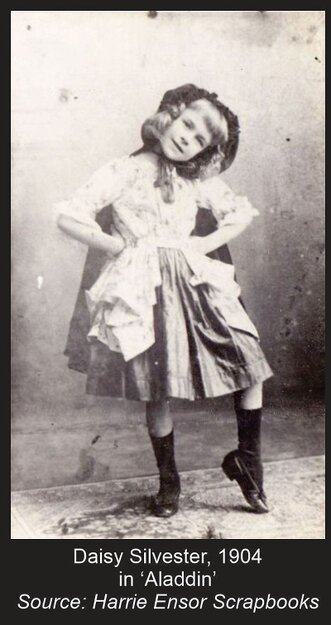
By 1897 she was working with her mother on the Rickard’s circuit, as Little Daisy Sylvester, and in 1903 was with the Gaiety Novelty Entertainers in Melbourne. New Zealand saw Daisy and Louisa/Louie in 1904, where Daisy was mentioned as “specially dainty, and is a dancer of merit, and a comedienne of originality.” … “proved a very charming young serio, quickly singing and dancing herself into the audience’s favour.” She was back in 1905 with Dix’s Gaiety Company and, twenty years later, when she returned to New Zealand in a production of ‘Aladdin’, the press called her Australia’s premier toe dancer.
The ’Gadfly’ in Adelaide (May 1907) humorously declared an infatuation with the “Scotch” dancer:-
“Daisy Silvester, a dainty little Scotch lady, with a winning smile and some twinkling toes, has come to the Tivoli, and the Tivoli is consequently feeling in good health and spirits. Daisy’s Highland whirl is really fascinating, and it is our firm intention to go to the Tivoli every evening until further notice, and impress upon the nice young man at the door that our sole reason for coming is that we are of Scotch birth. We shall also eat porridge for every meal; and if our wife wants to know why we want cakes and ale for breakfast, and our favourite bar-lady is surprised when we enquire why there is no haggis among the counter-lunch, we shall refer them to Daisy Silvester at the Tivoli. That’s how Brandon Cremer’s new serio has affected us, and if any member of the community doesn’t want to be tempted to don kilts and wear a thistle in his buttonhole, he should stay away from the theatre in King Street.”
Australian theatre work kept Daisy busy. In 1910 with Tait’s Variety Entertainers she “took the house by storm” at Geelong. With “The Follies” in Melbourne, Punch magazine said “the piece de resistance of the whole show is supplied by Miss Daisy Silvester, a dainty little comedienne, who dances with fascinating grace and ease.” For a tribute to her talent, the “Bulletin” commentary from February 2, 1911 cannot be surpassed:- “Miss Daisy Silvester, the toe dancer, puts her poetry of motion into a complete pirouette – well, at that brief moment the proximity of Paradise seems most appropriate.”
Daisy was not only a performer but would take on the role of directing the full ballet troupe in shows such as the “Follies” in 1910 and “Jack and the Beanstalk” at Melbourne’s Princess Theatre.
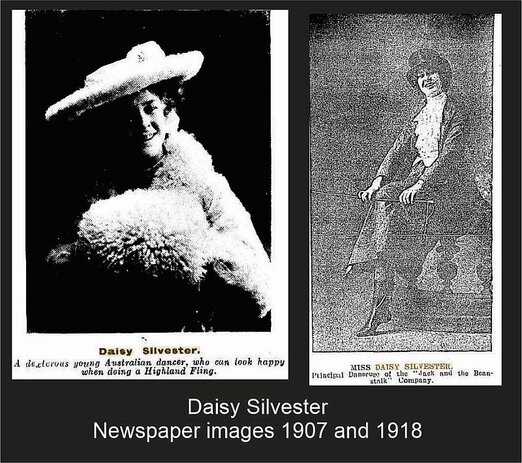
As early as 1916, Daisy was on the bill with an act named Will Kenny, a singer. Kenny’s real name was William James McDonald, some sixteen years older than Daisy. The pair married in 1921, and bore a son in 1925. Daisy was, since 1918, mostly retired from the stage but operating a school of dancing in Sydney; she did return to New Zealand in 1924. She later became a theatre usherette and worked at the State Theatre for over twenty years; in 1947 she suffered a fall at the theatre and fractured her skull.
Sadly, Daisy and William’s marriage, like so many theatrical pairings, ended in acrimony and divorce in 1949. Daisy continued to live in Sydney (108 Glenmore Road Paddington), retaining the preferred name “Kenny”. When magic historian, Harrie Ensor, came to visit, it was Mrs. Kenny and Mrs. Mullarkey who both provided the Silvester family photo albums from which he made so many copies; these are the photos attributed in this story to the ‘Ensor Scrapbooks’.
Daisy Silvester / Kenny McDonald died in Queensland in January 1957.
REFERENCES FOR CHAPTER NINE
(2) Inquirer and Commercial News, February 14, 1883
(3) Daily News, Perth, February 20, 1883
(4) See Dean Arnold’s site, “Dr. Lynn” at https://drhslynn.com/
(5) Victorian Express (Geraldton) January 21, 1888
(6) Daily News, Perth, February 28, 1888
(8) April 1891 Divorce Case files from the Public Record Office Victoria
https://prov.vic.gov.au/archive/DE9EFB15-F368-11E9-AE98-F37ECCF8AB09
https://prov.vic.gov.au/archive/DE9EFB15-F368-11E9-AE98-F37ECCF8AB09
Louisa was suing “in forma pauperis”
(9) Louisa’s quoted date of leaving Western Australia in August 1888, stated in her divorce papers, is not correct. She moved to Fremantle, then departed for Melbourne October 15, 1888.
(10) Evening Journal Adelaide, April 14, 1893 page 2
(11) Melbourne Punch, October 11, 1894
(12) The Age, Melbourne, October 16, 1894
(13) Mahatma magazine, February 1905
(14) Divorce papers 1916 and 1919 from Ancestry.com.au
Violet is referred to as both “Violet Isabell” and “Violet Isabelle” in these documents, but her birth registration from Western Australia shows her name as “Isabel”
Violet is referred to as both “Violet Isabell” and “Violet Isabelle” in these documents, but her birth registration from Western Australia shows her name as “Isabel”
(15) The Sun, October 26, 1947 p. 13
(16) Marriage to Joseph Lewis Bloor, and Violet’s death date sourced from NSW Births, Deaths and Marriages.
(17) Violet’s birth date, Feb. 20 1883 is confirmed by a copy of her birth certificate from W. A. Registrar of Births, Deaths and Marriages.